Assembling an Uber-Wonky Rainwater Harvesting System
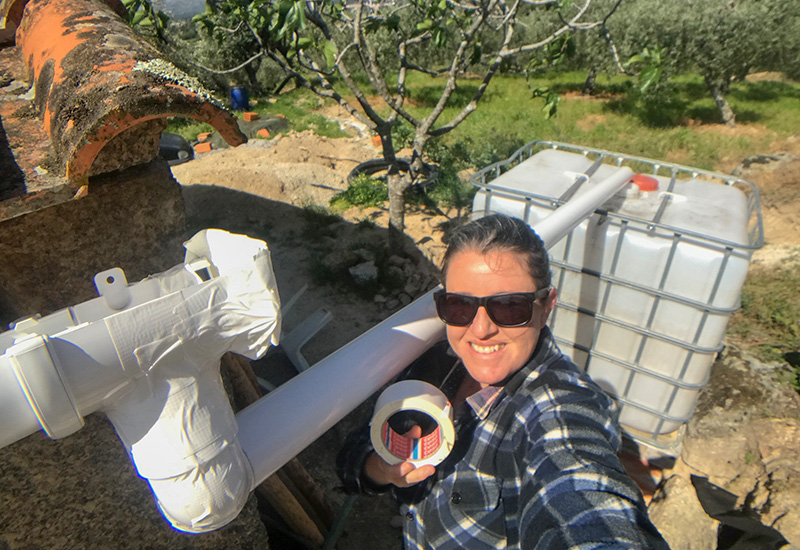
I’m somewhat intrigued but very apprehensive about plumbing. I know it would be a good idea to sort out an awesome water system for my entire land right from the start, but it’s a very daunting task for someone who’s barley got experience unclogging a drain.
To make the task a little less intimidating, I think it’s smart to first live on the land for awhile and observe. The two main things will be pretty basic – see how much water I have and keep track of how much water I use. I should be able to get a rough idea by figuring out how quickly or slowly my water cistern fills from the spring and also take notes on how much water I use for my needs within the house and for watering. But lets be honest, the likelihood of me keeping track of either of these things right now is about zero, so instead my plan is to hope for the best. Which is possibly not a plan at all. Possibly.
One thing I do know for sure is my water sources. It’ll either come from the sky when it rains, or it’ll slowly ooze out of the nearby mountain and the ground into my spring and well. Figuring out how to manage the spring and well water is rather daunting and I’ve been avoiding that for months. So instead I’ve chosen to focus on catching the rainwater and steering it around because that doesn’t involve pumps and power and I can actually wrap my head around the task.
Rainwater harvesting is all quite low-tech, but there will be best practices and proper ways to do certain things. I assure you that I haven’t done much research on the proper ways and I’m basically just following my gut on this one. Water falls from the sky, catch it, steer it to a tank, overflow it to more tanks, have a final overflow to somewhere on the land… how hard could it be?
Buying and Installing Gutters
In order to catch the rain from the roof of my creepy barn, the first thing I had to do was install gutters. Believe it or not, it took me until early March to get around to buying them – I tried several times to contact people about metal gutters, but those efforts proved futile. One of the shops in town could never manage to coordinate a delivery time with me and then they just drifted away, and another small company had a bit of back and forth on email but then faced the same fate. I suppose I could have been a bit more assertive, but I had so many other things to think about that it sort of got lost in the shuffle.
I eventually gave up on the idea of having metal gutters, even though I think they look way better than the plastic ones and even though the idea of having them installed by professionals certainly appealed. Instead, I opted to buy the plastic ones and have a go at installing them myself. The plastic ones seem to be available in the DIY shops in three metre lengths so I bribed a friend with a large van with lunch and fuel money, went into town, and finally bought gutters and all the other confusing plastic bits and metal fasteners that appeared to go with them.
Then it all sat inside my barn for a couple of weeks being in the way of absolutely everything, but I couldn’t install them because I forgot to buy the nuts and bolts I’d need. Then I attempted to buy nuts and bolts and the guy in the tool shop gave me the wrong size pairing. Ah! The saga of the gutters. Once I got the right sized nuts and bolts, I finally started to put the thing together on the ground which was not an easy task and involved the use of dish soap as I attempted to push pieces together that didn’t seem to want to fit. Then, when I finally had it all assembled, I realised that I only have two hands and putting the gutter up on my own would involve some sort of magic powers I do not possess. Luckily, a friend stopped by and I wrangled him into helping me get the six metre length of guttering clipped up onto the roof tiles.
I’d originally planned to put the gutters on both the front and back side of the roof, but I changed my mind and opted for just the back. Of course, this change in plans screwed me yet again because now I didn’t have the right pieces for the gutter puzzle. I headed back into town to get a different downspout but they didn’t have one in stock. I also needed a different corner-joining-thing (totally the technical term, I’m sure of it) to go at a 90 degree angle, but they didn’t have that either.
So now I had a gutter with a tank frustratingly close, but no way to get the water to the tank. The downspout I had combined with the different elbow type pieces didn’t want to work at first, but then I got a bit creative with duct tape and the pesky gutter and downspout bent to my will and was finally hooked up to spit the water out into the top of the tank. Hurrah!
Rainwater Storage
I’ve had a 1,000 tank (known as ‘IBC’ tanks in these parts) on my land since September, waiting patiently to catch rainwater. I’ve moved the massive, heavy tank around a few times (because no matter where I put it, it seems to be in my way) but otherwise I’ve neglected it while rain has fallen, un-harvested. Looking back, it seems like a massive waste of a rainy winter, but I suppose I had approximately a zillion other things to do, including the endless (but important) job of digging a French drain to steer water away from the bottom of my walls.
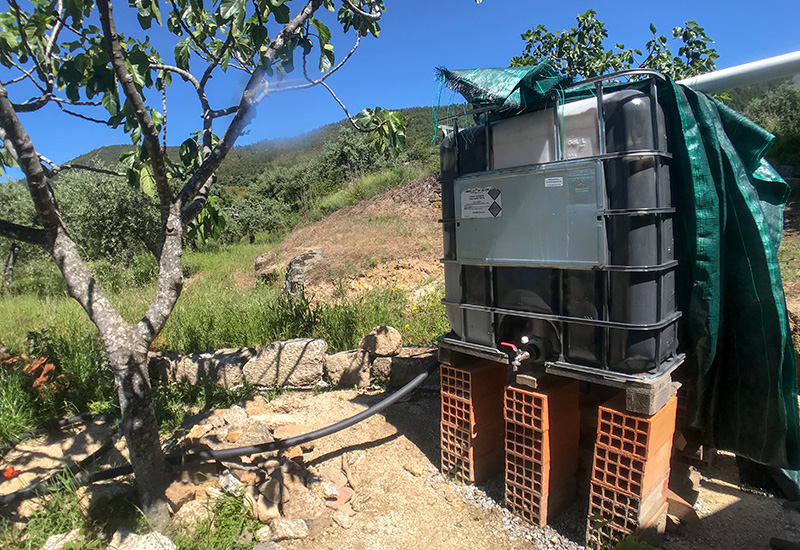
These IBC tanks can be found for sale for around 70 to 80 euros used. Some places claim not to know what’s ever been inside, other places assure you it’s only been sugar water and that nothing toxic has ever darkened its doorstep. I ended up buying my first tank used for €40 from friends who had been using it for storing water for their garden and they’re very particular about their garden so I have no doubts it’ll be good for storing water for showering, doing dishes, and watering plants and trees on my top terrace.
IBC tanks tend to be made from clear plastic and it’s pretty key to cover them from any sunlight so algae doesn’t get all up inside it. A friend gave me some silver foamy stuff that I’m calling ‘space plastic’ for one of my tanks and my plan for the other is to first spray paint it dark grey (because that’s the colour I happen to have) and then paint it white to reflect the heat of the sun.
My other tank, however, was a different story! I bought it from a shop in town called Rega Centro who are most excellent for advice on all things water-related, but I’m not sure they were completely honest with me about the tank I bought. I paid €80 euros for it and I was assured it had been cleaned out, but they recommended I still rinse it well before using. They claimed not to know what was inside but that it was nothing toxic. Well! It was filled with something quite strange that my friend and I guessed was either glue, face cream, or mayonnaise. We proposed a test of trying to stick two things together, putting it on a sandwich, or slathering it on our faces but that didn’t seem wise, somehow.
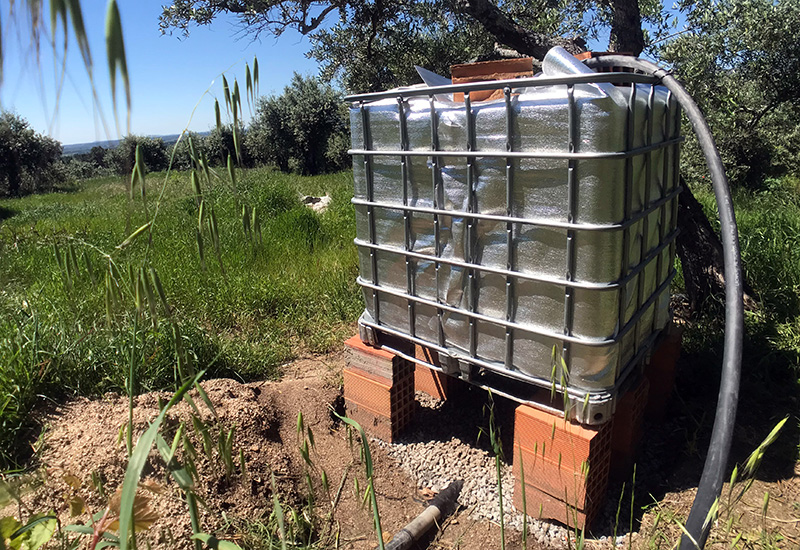
After much hassle I finally removed the gunk, cut out the weird bag inside (using my spoon carving knife attached to a metal stick… new tool!), and then rinsed the tank as many times as my soul could manage and cleaned it with dish soap. It’s difficult to say whether I got it all out or whether I’m coating my precious trees in some sort of glue/mayo/face cream/dish soap creation. Time will tell. Anyway, don’t buy an IBC before first checking for interior ooze.
Overflow
Catching and storing water is one thing, but figuring out what to do when the tank is full is a whole other thing to think about. My eventual plan is to have overflow pipes that sort of cascade from my top tank all the way to the bottom of my land, filling other tanks along the way. It seems a shame not to catch as much rainwater as possible and having storage and pipes in place to do that will take a bit of planning, but I’m looking forward to designing something.
As it stands, right now, I have 50 meters of unruly black pipe that I’ve managed to connect to a hole I drilled into the top of the tank at the top of my land. This currently snakes its way down my land and goes into the top of a tank on my third terrace. The overflow for that tank just spills out of the top (where I’ve left the lid loose) onto the ground which isn’t ideal but it’s ok for now. This will give me a whole extra 1,000 litres down where I have my trees in case of a water emergency.
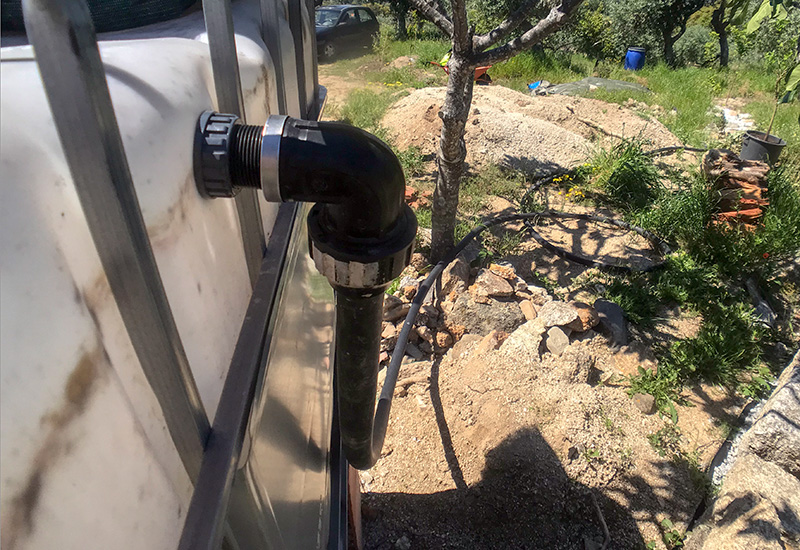
Eventually I want two or possibly three more tanks, but it’ll probably have to wait until next year because I’m on the verge of being broke. But really, I think water storage is one of the best ways to spend my money right now, so I might just bite the bullet and go for it and eat tins of beans for the foreseeable future. Though it’s probably wise to observe how my current system is working for awhile before jumping into major infrastructure setups… so we’ll see.
Eventually I’d like a tank each on terrace two and four and I’m wondering if I might also want an extra tank up beside my house since I’ll be using that water both for my plants and for myself in the house. The idea is to fill the tanks as the rainwater cascades down my land in overflow pipes, eventually spilling over either into my well on the bottom terrace or maybe one day I’ll make a small pond down there.
Catching Rainwater in the Soil
When I think of rainwater harvesting, my mind initially goes to gutters and tanks, but it’s possibly even more important to collect and direct rainwater and sink it back into the soil before it has a chance to run off your land, taking valuable topsoil with it and causing erosion. I’m not so experienced with this stuff, but I know that many people accomplish this using some combination of swales and ponds.
My land is terraced which means that each level is mostly flat with drops of various heights held up by stone walls. This means that swales, which are dug on contours to prevent water from rushing down hills, wouldn’t be so useful since I don’t have contours. I have considered digging a small pond on the bottom terrace where I can direct all of my overflow water to, but hacking a hole into my land isn’t something I’ll do without at least a couple of rainy seasons worth of observation. I suspect that my well leaks water out the sides slowly, so I think I’ll first attempt to direct all of the excess water into that and see what happens. If the well holds the water, great! If not, at least it’s slowly leaking out into the surrounding land which is also good.
Plumbing and Pipes
So once you’ve got some gutters and tanks and a general idea of how the water will flow around your land, you need the actual plumbing and pipes to connect it all together and make the magic happen. To buy all of these bits, you need to know which plumbing gizmos and doodads and pipe types and sizes are required to accomplish the vision. I do not know this information. It truly is a world of confusion and I haven’t yet figured this part out with any level of confidence. After a quick spin through YouTube hell, I learned about downspouts, valves, threads, adapters, first flush extractors, overflows, and many more exceptionally boring but very useful things. I’ve spent plenty of time boring friends with questions about plumbing and looking at their setups, but I still haven’t fully wrapped my head around it all.
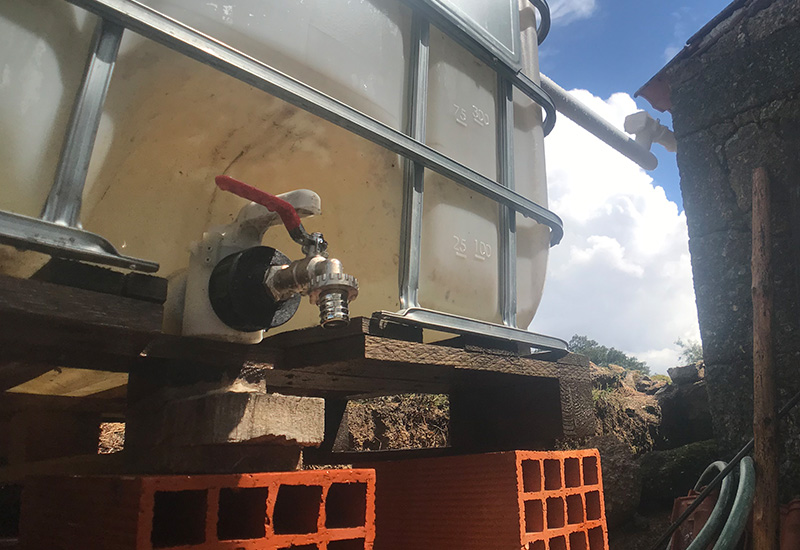
The good news is that, while I find all of this stuff very confusing while I’m reading about it or watching a video, when I actually get my hands on the stuff, become familiar with the parts, and start to assemble it myself and see it all in action, it very quickly becomes clear how it all works. Nothing I’ve encountered so far is really that difficult to suss out and I’m actually quite excited about future plumbing challenges that lie ahead. The tricky part is being in the shop and actually knowing what to ask for so I’ve found the best approach is to wander in with the pieces of pipe and fittings that I need to attach things to and then go from there.
My Current Rainwater Harvesting System
So what have I ended up doing, you ask? Let me tell you! It’s a very temporary solution and it will continuously evolve, but for the moment it does the trick… just in time for the dry summer season! Oops.
- I’ve attached plastic gutters to one side of my roof which is about 18 square metres.
- The gutter flows into a pipe that is perched at the to of my 1,000 litre IBC water tank, held together with duct tape (oh ya!)
- In order to prevent algae, I’m in the process of spray painting the tank dark grey but I ran out of paint. As a temporary solution, I’ve wrapped it in a sort of garden sheeting (that’s designed to suppress weeds) but that looks pretty crappy and doesn’t do a good job, so I need to get more paint ASAP.
- I don’t currently have any sort of screen over the opening on top of the tank, so I need to get something there soon to stop creatures falling into it and hopefully to prevent mosquitoes going in and having a breeding heyday.
- I screwed a hole close to the top and added a 25mm pipe as an overflow. Currently the pipe is part of a massive 50 metre roll that snakes down into the top of the second IBC tank on my third terrace.
- I’ve cleaned the second tank and wrapped it in a shiny silver this foam-like substance that seems like it’ll be great for keeping the sun out.
- That’s where the water journey ends… right now any overflow will just spill out the top of the second tank onto the ground which isn’t ideal.
My Future Rainwater Harvesting Plans
I have lots of plans for making a great system for moving rainwater around my land but I probably won’t do anything about them until closer to autumn when the rains are due to fall again.
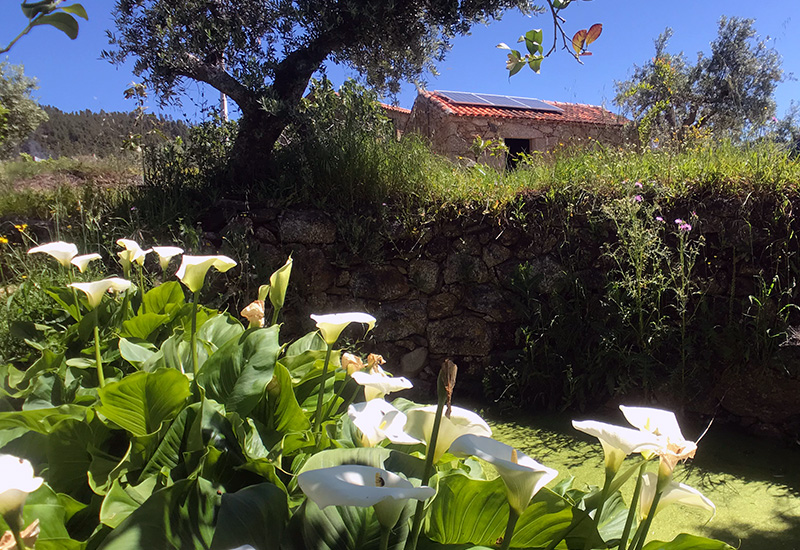
- I’ll attach gutters to the front side of my roof which will take the total water catchment area to around 36 m2.
- I need to either repair my cistern to a good standard or find a temporary fix where I make a small basin to catch he continually flowing spring water. At the moment it just leaks out of my cistern into the surrounding ground where a lily forest has taken over. I’d like to instead catch it and steer it into tanks and around my land.
- I want to get at least two more IBC tanks so I have one on each terrace. I’d like to design a system where water from my spring overflows from the cistern down my land, topping up each IBC before eventually ending either in my well or a pond.
- My plan is to add six 240 litre barrels to the narrow space behind my house and somehow connect them to the IBC and to each other to be able to catch an additional 1,400 litres of water by my house (but this might be too much of a faff so I might instead use that space as storage for long things).
- I’ll put gutters on any future structures I make, even just to steer water into small barrels or to specific areas of my land.
- I’d like to repair the huge but crumbling cistern located on the fourth terrace at the bottom of my land next to the well which I also suspect has a natural spring flowing into it.
- Eventually I’ll like to turn one of my cisterns into some sort of a natural plunge pool as a reprieve from the brutal Portuguese summers.
Summary
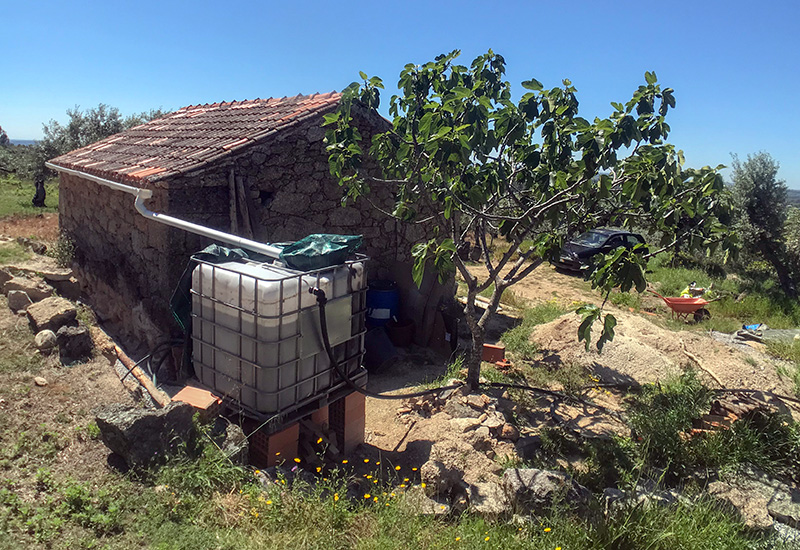
Seeing my tanks full of water that’s fallen from the sky always makes me smile and I know that, with a plan and a few bits of infrastructure type things, it’s an easy way to have water on hand where you want it during the wet season. Sure, the rain will water the trees and plants but what about when it stops? Having to use power or fuel to pump from somewhere seems like such a waste of resources when filling those tanks really is as simple as having some gutters, pipes, and a roof. If you’ve got a piece of land that has some slopes and/or terraces then the possibilities of what you can do with gravity are pretty exciting, too!
Another added bonus is that with some smart design ideas, I can use my rainwater harvesting setup with my pump during the dry season. So when the water isn’t falling from the sky I can, in theory, pump water from my cistern into the top tank and then have it flow down to the rest of the tanks without having to pump to them individually. That’s the idea, anyway!
Unfortunately, this rainwater plan only works when the rain is falling so I’m working now on figuring out the rest of the system which will require pumps and valves and filters and lots of taps and pipes and who knows what else. I’ll need to get on that sooner rather than later because the summer is coming, so I guess I need to get planning!


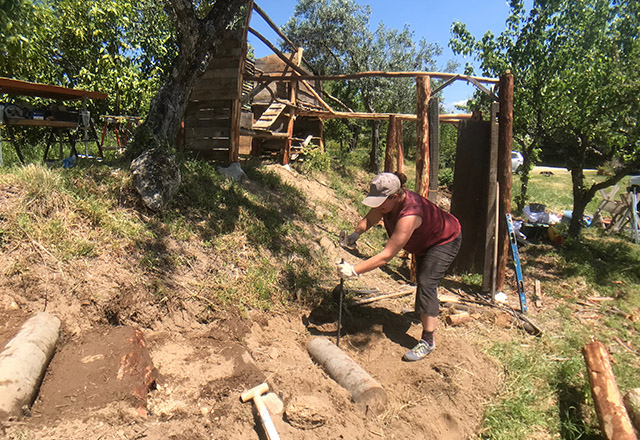
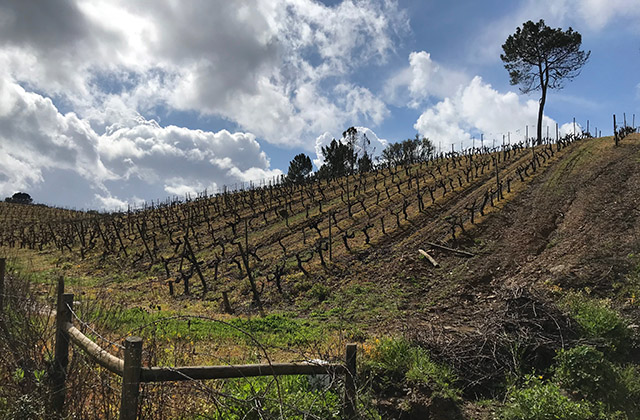
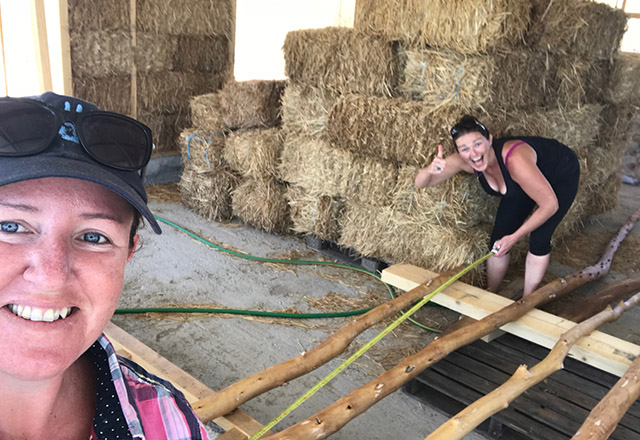

Brilliant blog Kirsty, have you looked up Geoff Lawton, he’s a permaculture guru. Does a lot with rainwater harvesting.
I rediscovered my blog reader just a few days ago, and now your story popped up! How exciting! I wish I could move out into the wild like you did… as for the water catchment, I’m terrible at this… and most other water systems too! But I’m learning about ponds and natural aquariums, all the aquatic plants… and maybe one day I will be a pro at navigating gutter systems and tanks too. Or maybe not 😉
I wish you all the best!